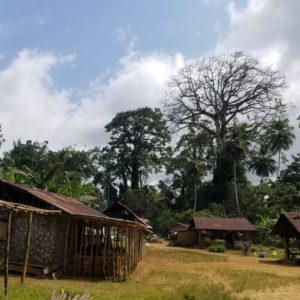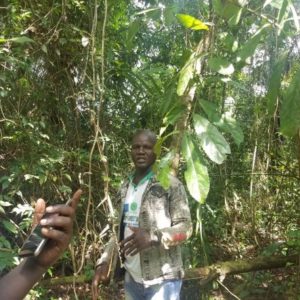PHOTO: Harmonville Village credit: William Selmah
By William Selmah,wselmah@gmail.com with New Narratives
Barconnie and Harmonville Community Forest, Grand Bassa County – Powerful forces push the people of the 21 towns that make up this community forest area to abandon their efforts at conservation every day. Big money offered by foreign and local business people, amidst hardship, tempts them from their path. But the people say one thing is keeping them focused: future generations.
“We want our children, our children’s children and even the ones coming after them to see this forest whole like this and to see the different, different animals and plants,” says Alphonso Dennis, Town Chief of Barconnie-Blewein.
The people of these neighboring towns decided to establish a protected forest area following series of education and enlightenment programs provided by conservation institutions. They were eye-opening says Chief Dennis.
“We never knew the importance of our forest until we met some groups like Farfare, Conservation International and others.”
Now, from the youngest to the oldest, literate and illiterate, leaders and citizens, the pride these townspeople feel in their conservation efforts is obvious.

Alphonso Dennis, Town Chief of Barconnie-Bleewein. Credit: William Selmah
When the Forestry Reform Law came into effect in 2006 the Barconnie-Harmonville Community Forest was one of just eight community forest areas in the country that decided to follow the path of conservation. That law gave local authorities more control over their forest land. They were persuaded that by conserving their forests they would one day see such protected area gradually transformed into a tourism site that would generate funds for the community while at the same time keeping their forest intact. Besides, most of their environment would be protected and that their current plant and animal species would be saved from extinction.
Prior to declaring their forest protected area, several towns and villages had suffered severe storm effects. Roofs were often blown away from house tops during heavy storms. Among the first assistance the community received then was teaching on how to protect their environment from storms by keeping bushes and trees around their villages. “The surrounding of our town, Barconnie here mainly, was slowly turning into savanna”, said Opa Peters, Officer in charge of the community forest. As the years went by, however, community dwellers stopped worrying about heavy storms because of the shield of protection from trees and bushes. Meanwhile, the remaining 44 communities are all commercializing their forests to various foreign and local concessions.
Like Barconnie and Harmonville, all 52 of the Community Forest Management Bodies or CFMBs (the bodies representing the business interests of the communities in logging contracts and other deals) were severally visited by conservation groups who explained the conservation benefits to them. But powerful local chiefs, politicians and even lawmakers from other forest communities rejected the opportunity to sustainably use and manage the forests but instead sought to make quick money through commercial activities including logging, mining and clearing the land for agriculture.
But in the last few years, those communities that opted for commercialization have struggled to get the payments they were are due from those activities. Communities are entitled to a 30% share of monies paid to the government as land rental fee. Government and the concessions owe the 44 communities more than $US3 million in rental arrears, according to Annie Jerrue, Vice President for Operations of the National Union of Community Forest Development Committees. $US200,000 was paid in October this year, after the communities demonstrated at the Finance Ministry in Monrovia over the non-payment. The Ministry promised to settle remaining arrears in coming days. At date of publication that has not happened.
Dennis said though the difficulties being faced by his people are numerous, it’s not going to give them any reason to turn their backs to conservation and begin destroying their forests again as was done in time past.
“We went through these challenges and we’re still going through them. But people are getting used to it because we have rules and regulations that govern protected areas. No one can tamper with those places”, he said with confidence.
“You see, for most of our children, or youth nowadays, they don’t know some of the things that are in our forest; even the animals that are within our forest,” said Adolphus Deputies, General Secretary of the Executive Committee of the Barconnie-Harmonville Community Forest Management Body (CFMB). The Executive Committee is the highest decision making body of the CFMB.
“So what we do is we educate them on the importance of the forest and things that are within the forest; even the ones they have not seen – animals that they do not know by their names, how they exist and how they are important to the environment. So these are some of the education we are carry on to make sure that the forests are protected. We will continue doing this, as long as the forests exist.”
Barconnie and Harmonville, like every community, have also had their share of temptation from foreign investors to make business of their forest. ‘They’ve been coming to us”, Peters said, with the latest being the German interest, Big Joe Town Logging Company also in Grand Bassa County. But their answer has always remained NO.
Barconnie and Harmonville have won the admiration of several conservation groups for their stance. In September the Sustainable Development Institute (SDI) donated a motorized boat and accessories as well as fishing nets to them in recognition of their efforts and to help the community find alternative livelihood sources in their conservation endeavors.
The donations from SDI were the first of their kind in the 14 years (2007-2021) since the community declared their forest a protected area, according to Opa Peters, Chief Officer of the Barconnie-Haronville CFMB. That was reiterated then by Wilfred Gray-Johnson, SDI Executive Director during the donation.
Mr. Peters says the items will be useful, but compared them to a drop in the ocean, considering their vast needs. “These things are not sufficient, though we are grateful,” he says. “The main thing in carrying on conservation is the people’s livelihood. The last time I had an interview, I said if I had my own will or the authority to be an official at FDA [Forestry Development Authority], I would focus on conservation, Okay”? He appealed to partners to place community support, including livelihood development at the top of their priorities.

Towns and villages here are among the poorest of poor rural communities in Liberia – with basic social services including schools and health centers largely nonexistent. Markets and provision shops to buy basic, daily necessities are also hard to come by.
“There is nothing like good living in those communities”, said Paul Larry George, Chairman of the Alliance for Rural Democracy – a local NGO that has been helping indigenous people, in collaboration with Green Advocates International, to get back land unjustly taken away from them and given to concessions in Bong, Margibi and Grand Bassa Counties. “Most of the rural communities are living normal poverty lives. Imagine a generation of children growing up without education, pregnant women without access to maternity services and must walk hours or seek motorcycle transport in order to reach the nearest health post when in labor pain”. George said even those living in concession areas are no better than the others.
Time is indeed testing the resolve of residents of the rural settlements to continue to keep their forests. In most parts of the community there are no healthcare centers and no schools. The lack of more alternative livelihood sources remains a shared, challenge.

Opa Peters/Officer-in-Charge, Community Forest/Credit: William Selmah
Because of the lack of schools in their area some parents are compelled to send their children to live with people areas in order to gain education.. This is exposing kids to the risk of abuse according to Mondayma Cered, an elderly woman of Harmonville Township # 3 A. “Because we don’t have any school here, we’re forced to give our children to other people to help with their school business and sometimes they treat them really, really bad. Some of them run away and come back to us.”
Though his people are determined to stick with their conversation plan, it has become increasingly difficult according to Mr. Peters. Without access to bush meat and other forest resources, he says people are barely making ends meet. He pleaded for partners to help.
“When you put stop to me from going into to the forest, from hunting, what is the next thing? You find different means for me,” he said.
The secondary forest is the only remaining area for people here to engage in some forms of livelihood activities like farming and hunting. Barconnie and Harmonville have two forest covers: primary and secondary forests. The primary is the strictly no go area, while the secondary permits activities but subject to permission and licensing from the Executive Committee of the CFMB. “If you want to plant cassava, for example, you send in your request and we interview you on several things. Once it makes sense, we demarcate the plot of land for you to go ahead But if you clear the land and fail to complete the project or do different thing on it, we fine you heavily, and if you fail to pay, you could go to jail for up to two years”. Chief Dennis said.
The community has a long history of successful conservation activities including protecting mangrove swamps areas and, sea turtles in collaboration with the Society for the Conservation of Nature in Liberia (SCNL).
Those programs succeeded, because it is a community of hospitable and serious minded people, according to Michael Garbo, head of SCNL
“We set up a conservation group that could monitor the sea turtles and thereby in the conservation agreement, they could receive a monthly token for monitoring or observing the mangrove,” Mr. Garbo said. He urged donors to help SNCL support the community’s ongoing conservation groups.
“SCNL is willing, is happy to work with these communities to carry on alternative livelihood programs,” he said. He said people who permit themselves to be restricted from going to areas in which they got their feeds and other needs should be supported to find other ways of finding food and resources.
Conservation International had previously funded SCNL to support communities involved with such programs and is certain they will again be willing to do so again.
“It is again left with us to get back to Conservation International or look at other sources of funding – the Liberia Forest Sector Project or other donors so that we are able to source funding and continue our activities in the Barconnie forest.” This story was a collaboration with New Narratives as part of it’s Land Rights and Climate Responding Project. Funding was provided by the UK Foreign and Commonwealth Development Office and the American Jewish World Service. The Funders had no say in the story’s content

